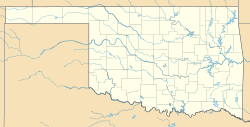Keota, Oklahoma facts for kids
Quick facts for kids
Keota, Oklahoma
|
|
|---|---|
| Country | United States |
| State | Oklahoma |
| County | Haskell |
| Area | |
| • Total | 0.38 sq mi (0.98 km2) |
| • Land | 0.38 sq mi (0.97 km2) |
| • Water | 0.00 sq mi (0.00 km2) |
| Elevation | 489 ft (149 m) |
| Population
(2020)
|
|
| • Total | 437 |
| • Density | 1,162.23/sq mi (448.31/km2) |
| Time zone | UTC-6 (Central (CST)) |
| • Summer (DST) | UTC-5 (CDT) |
| ZIP code |
74941
|
| Area code(s) | 539/918 |
| FIPS code | 40-39500 |
| GNIS feature ID | 2412827 |
Keota is a small town in southeastern Haskell County, Oklahoma, United States. In 2020, about 437 people lived there. This was a decrease from 564 people in 2010.
Contents
History of Keota
Keota was first known as "KeeOtter." Later, its name was changed to "Keota." The name might come from a Choctaw word meaning "the fire gone out." This could refer to a tribe that was wiped out by disease.
Another idea is that the name comes from "Jim Keese," a rancher who owned the land. The "Otter" part might be from Otter Creek, a stream that flows through the town.
Founding and Early Growth
The town of Keota was started in 1904 by the Midland Valley Railroad's land company. A post office opened in 1905.
By 1911, Keota had many businesses, a hotel, and a lumberyard. The town was important for local cotton farmers. It was a place where they could ship their cotton by train.
Changes Over Time
The Great Depression was a tough time for many towns. Keota's population dropped from 494 people in 1920 to 470 in 1930. However, it grew back to 619 people by 1970.
In 1971, the McClellan–Kerr Arkansas River Navigation System was built. This system helps boats travel on the Arkansas River, which is about 10 miles north of Keota. A dam on the river created the Robert S. Kerr Reservoir, a large lake that reaches Keota.
This new waterway helped create the Port of Keota. Some light industries started to come to the town. However, by 2013, the port was mostly just a boat launch. The railway that once served the town was no longer used.
Historical Sites
On December 31, 1974, the Otter Creek Archaeological Site was added to the National Register of Historic Places. This means it's an important historical site.
When Keota was founded, it was part of the Moshulatubbee District of the Choctaw Nation.
Geography of Keota
Keota is located about 38 miles (61 km) west of Fort Smith, Arkansas. It is also about 28 miles (45 km) south-southwest of Sallisaw.
The town covers a total area of about 0.4 square miles (0.98 square kilometers). All of this area is land.
Population and People
| Historical population | |||
|---|---|---|---|
| Census | Pop. | %± | |
| 1920 | 494 | — | |
| 1930 | 470 | −4.9% | |
| 1940 | 525 | 11.7% | |
| 1950 | 619 | 17.9% | |
| 1960 | 579 | −6.5% | |
| 1970 | 685 | 18.3% | |
| 1980 | 661 | −3.5% | |
| 1990 | 625 | −5.4% | |
| 2000 | 517 | −17.3% | |
| 2010 | 564 | 9.1% | |
| 2020 | 437 | −22.5% | |
| U.S. Decennial Census | |||
In 2000, there were 517 people living in Keota. These people lived in 204 households, and 140 of these were families.
About 37% of households had children under 18 living with them. Many households (about 55%) were married couples living together. About 15% of households had someone living alone who was 65 years old or older.
The average age of people in Keota was 34 years old. About 31% of the population was under 18.
Notable People from Keota
- Sim Iness - An Olympic gold medalist and world record holder in the discus throw.
- Major General Sidney Marks - A respected infantry officer in World War II and an All-American wrestler.
See also
 In Spanish: Keota (Oklahoma) para niños
In Spanish: Keota (Oklahoma) para niños



